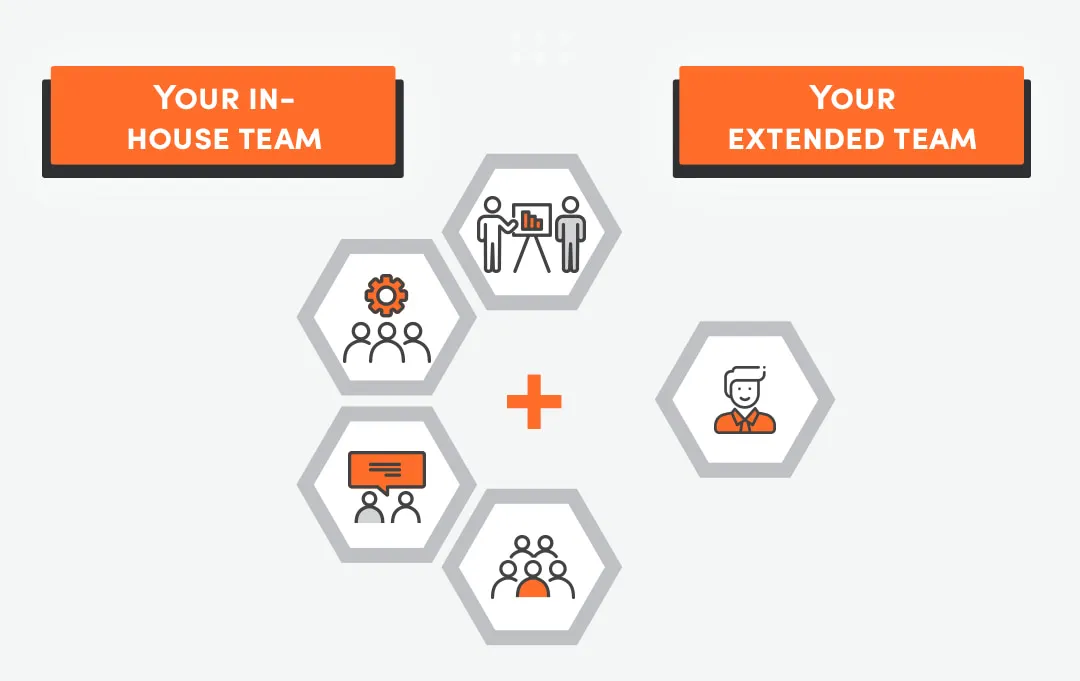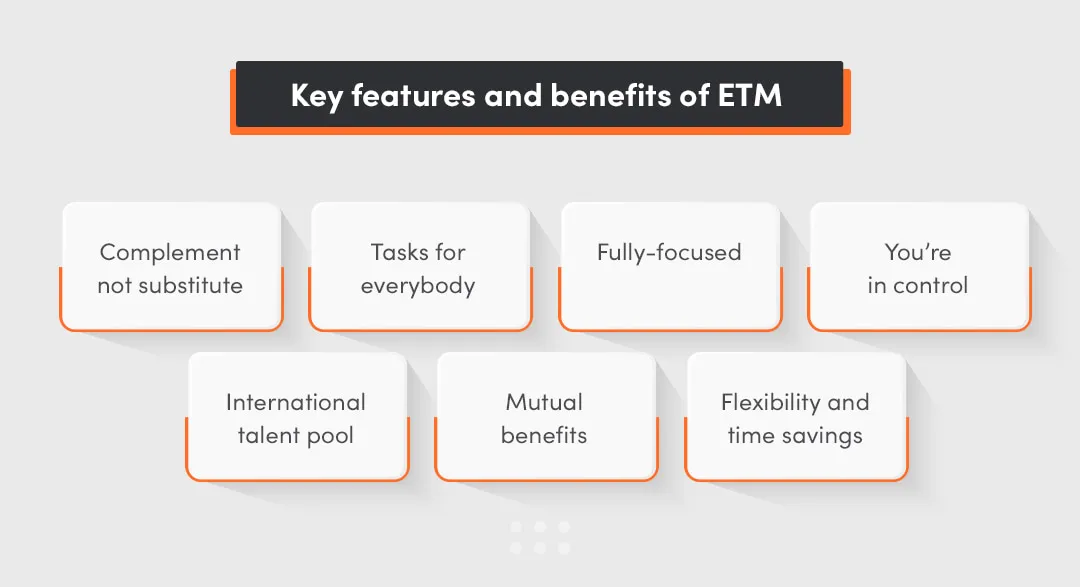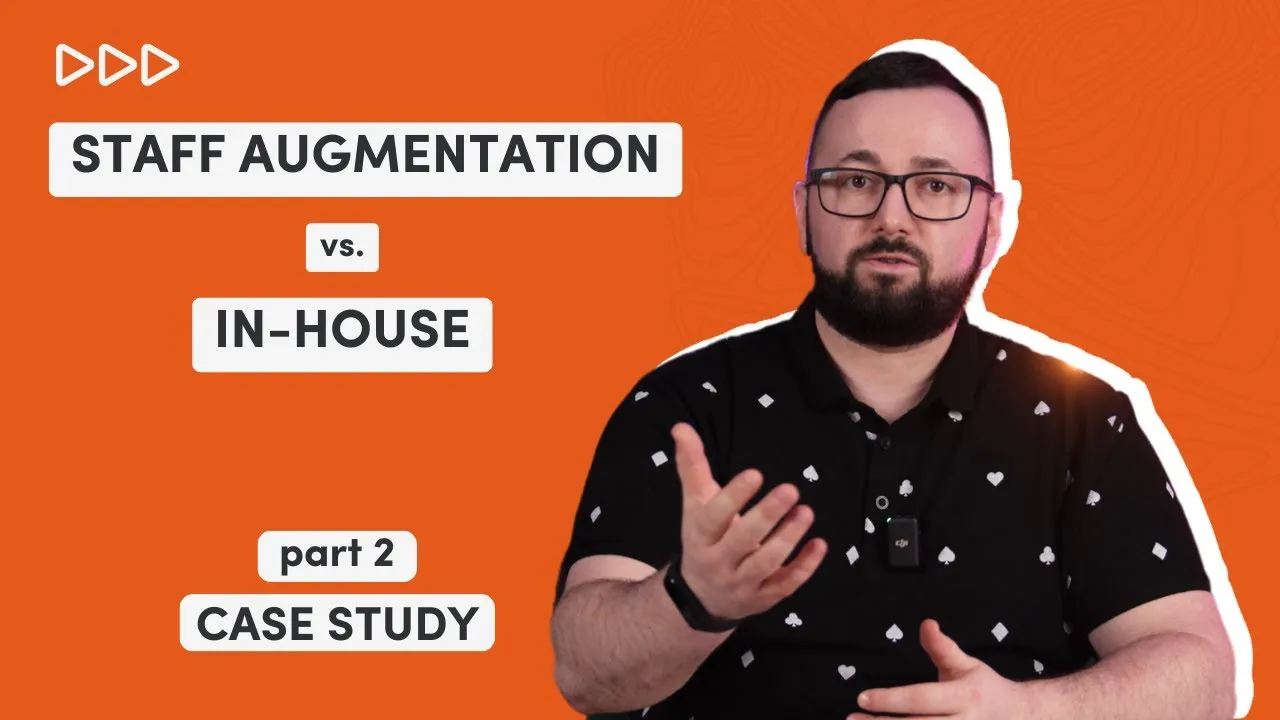It’s no secret that having the right people around is one of the key ingredients for the project's success. SMEs and startups often face difficulties with adding resources to an existing team, especially with specific skill sets. In traditional outsourcing, there is little reliance on the in-house team. Here’s when the Extended Team Model comes to the rescue.
In this article you will learn:
- What is the main difference between the Extended Team Model (ETM) and traditional outsourcing?
- Why is the ETM considered more flexible than traditional outsourcing?
- In what scenarios is the Extended Team Model most suitable for a company?
- What are the key features and benefits of the Extended Team Model?
What Is An Extended Team Model (ETM)?

An Extended Team (often also called staff augmentation) is a type of product development model. The core part of the development team is located in-house while being extended by a team of remote developers. Both teams collaborate with each other, complementing the lacking skills or experience.
The extending team can be both nearshored (to a bordering country) or offshored (to a different continent). There’s no right or wrong, the most important part is that the team you decide to work with is an extension of your company.
But how is the Extended Team Model Different from Outsourcing?
There is one crucial difference between outsourcing and working in an extended team model - location. To outsource means the entire development process is transferred to an external team, often located in a different country.
Outsourcing also does not necessarily mean a long-term collaboration, whereas it is the main aim of the Extended Team Model.
Try our developers.
Free for 2 weeks.
No risk. Just results. Get a feel for our process, speed, and quality — work with our developers for a trial sprint and see why global companies choose Selleo.
Key features and benefits of ETM
Although the overall rules of collaboration between ETM and traditional outsourcing are quite similar, some specific features differentiate them, such as:

Complement not substitute
The remote team is meant to complement the in-house team and not substitute it. Its main goal is to fill the skill or experience gaps. It becomes a part of the company, sharing its visions and needs while leveraging the existing resources.
Tasks for everybody
Tasks and responsibilities are evenly distributed among the members of both the internal and external teams. However, project management remains within the core in-house team.
Fully-focused
Extended developer teams are completely invested in your project as they’re not juggling a few different projects. After the project is completed, external teams are not broken up. They are aiming for a long-term collaboration.
You’re in control
The project management team controls the key points of collaboration and takes part in the decision-making process. Working with an external team allows for maintaining integration with complex internal processes
International talent pool
Extended Team Model introduces cost savings and versatility. You get access to the international talent pool and a variety of hourly rates.
Mutual benefits
In-house teams often benefit from working with an extended team. It gives them the ability to learn from each other, share tips and work on solving problems together. Introducing ETM ensures the in-house team stays lean and efficient. Only essential staff is applied, leaving no room for cutbacks and downtime
Flexibility and time savings
This model of collaboration introduces scalability and flexibility without the recruitment hassle. Going with an ETM saves time and effort that would normally be spent during the recruiting and training process.
You can build a team faster and skip worrying about finding a working space for the new team members. An External Team Model is easier to introduce and adapt to the company than outsourcing
When to Use the Extended Team Model?
Extended Team Model is a great fit when you’re lacking skilled developers who could support your team. The ETM will also be for you if you want to start a side project and don’t want your core team getting distracted from the main project. It’s best for projects that are meant to be gradually expanded.
You should also choose the Extended Team Model when you want to have full control over the processes and want to get involved in a long-lasting collaboration.
However, if you lack an IT team, need to develop a one-time project or want to delegate the entire development process to an external company, going with old-school outsourcing would be better.
Summary
The Extended Team Model is a collaboration based on mutual trust, shared values and transparency. It’s working towards a common goal while establishing emotional connections and remaining flexible.
It’s a great solution when your IT team lacks experience or skills and you don’t want to go through the recruitment process or can’t find suitable engineers.
If you’re in the middle of looking for an amazing external team, look no more - Selleo is excited to work with you on any model you choose. Check out one of our teams.
An Extended Team in Agile refers to a collaborative model where an in-house Agile team is augmented with external specialists or developers to fill skill or experience gaps. Unlike traditional outsourcing, the extended team works closely with the in-house team, following the same Agile principles, such as iterative development, collaboration, and transparency. This model ensures the external team is fully integrated into the project, contributing to sprint planning, daily stand-ups, and retrospective meetings, as needed. The extended team complements the core team rather than replacing it, ensuring alignment with the company’s vision and goals. This approach is particularly valuable for scaling projects quickly or accessing specialized expertise without the delays of traditional recruitment processes.
The core team refers to the in-house group of professionals who are directly employed by the company and responsible for the foundational aspects of a project. They typically manage critical decision-making, project management, and long-term strategies while maintaining organizational continuity.
In contrast, the extended team consists of external specialists or developers who collaborate with the core team to fill specific skill gaps or provide additional capacity. The extended team is not a substitute but a complement to the core team, aligning with the company’s processes and goals while being fully integrated into the project workflow.
Unlike the core team, the extended team is usually brought in temporarily or for specific tasks, offering flexibility and scalability without the long-term commitment of hiring permanent staff.
The Extended Team Model (ETM) is an alternative to IT outsourcing, but these two remain viable solutions in different scenarios. ETM is better suited for projects where close collaboration, control over the development process, and long-term integration with the in-house team are priorities. It complements the in-house team by filling skill gaps and aligning with the company’s vision, making it ideal for scaling projects or accessing specialized expertise. Outsourcing, however, is more effective for standalone or one-off projects where the entire development process can be delegated to an external team, often with cost savings as a key focus. Both models offer unique advantages, and the choice between them depends on the project’s scope, complexity, and the company’s strategic goals.





